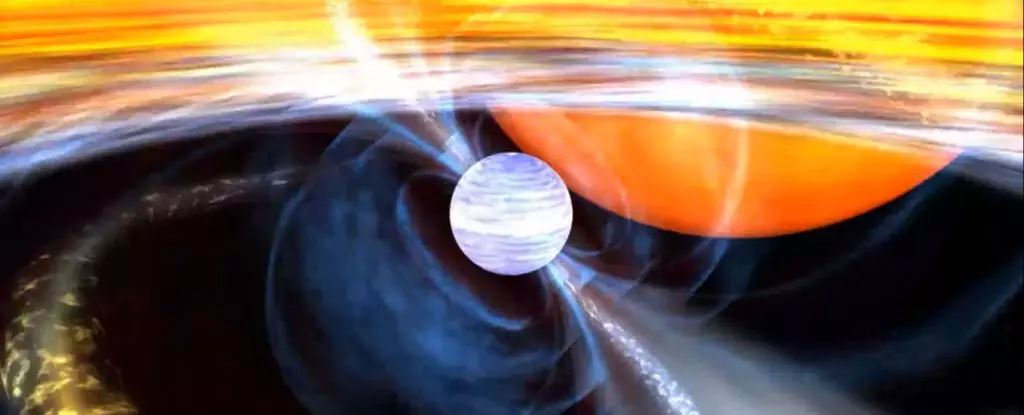Recent stellar discoveries remind us that the cosmos is a stage for some of nature’s most extraordinary phenomena. One such captivating spectacle is unfolding in the binary star system known as 4U 1820-30, located an astounding 27,400 light-years from Earth. Within this celestial dance, scientists have identified a neutron star that rotates at a staggering speed of 716 times per second. This remarkable find not only pushes the boundaries of our understanding of neutron stars but also redefines our knowledge of the limits of stellar rotation.
Neutron stars are the remnants of massive stars that have undergone supernova explosions—cataclysmic events marking the end of a star’s life cycle. When stars with a mass ranging from 8 to 30 times that of our Sun exhaust their nuclear fuel, they collapse under the force of gravity, compacting their core into the incredibly dense structure we identify as a neutron star. These small, intensely dense objects—usually no more than 20 kilometers in diameter—are a testament to the universe’s incredible forces at play.
In the grand cosmic theater, neutron stars can exhibit various behaviors based on their unique characteristics. Two notable types are magnetars and pulsars. Magnetars possess extraordinary magnetic fields, while pulsars like the luminosity-rich PSR J1748-2446ad emit beams of radiation, acting as cosmic lighthouses. The neutron star in 4U 1820-30, however, is particularly intriguing. It resides in a binary system with a white dwarf, where it siphons mass from its companion, leading to periodic thermonuclear explosions.
This binary system has been known to astronomers since at least the 1980s, lying nestled within the constellation Sagittarius. The close orbital relationship between the neutron star and the white dwarf results in a swift 11.4-minute orbital period, enhancing the neutron star’s ability to accrete matter. As material from the white dwarf accumulates on the neutron star’s surface, it forms a layer of increasingly dense and hot gas, ultimately culminating in spectacular thermonuclear events that can illuminate the star up to 100,000 times brighter than our Sun.
Astrophysicist Gaurava Jaisawal and his team at the Technical University of Denmark took on the challenge of studying these explosive bursts, utilizing NASA’s Neutron Star Interior Composition Explorer (NICER). This advanced X-ray telescope is mounted on the International Space Station (ISS) and provided essential insights into the phenomena surrounding 4U 1820-30. The recent analysis revealed a unique oscillation frequency of 716 Hertz during one of the thermonuclear explosions—a signature that implies a connection between the neutron star’s rapid rotation and its energetic outbursts.
If confirmed, this pulsar-like behavior suggests that 4U 1820-30 may be the fastest known nuclear-powered pulsar, surpassing even PSR J1748-2446ad in the realm of stellar speed. Such a discovery opens doors to novel avenues of research, potentially providing an unparalleled vantage point to study the extreme conditions under which neutron stars exist. Each thermonuclear blast offers a glimpse into the lifecycle of binary star systems and enhances our understanding of elemental formation in the universe.
Jerome Chenevez, another astrophysicist involved in the study, emphasizes that these extreme events serve as critical windows into the dynamics of stellar evolution. By detailing and analyzing these explosive phases, researchers can unravel the intricacies of neutron star behavior, which remain shrouded in mystery. Observing high-energy events from neutron stars deepens our understanding of how matter behaves under extraordinary gravitational forces—knowledge that could eventually extend to theories of nuclear physics and the fundamental nature of matter itself.
The findings surrounding 4U 1820-30 illustrate the infinite wonders of our universe and highlight the ongoing challenges faced by researchers seeking to unlock its secrets. Further observations will be required to validate the unique characteristics of this pulsar, indicating that the journey into the mysteries of neutron stars is far from over. Each new revelation reminds us of the cosmic symphony in which we are all participants, reigniting our curiosity about the universe and our place within it.
As technology advances and our exploratory capabilities expand, we remain on the cusp of groundbreaking discoveries that could redefine our understanding of stellar life cycles and the fundamental workings of cosmic phenomena. In the heart of the cosmos, amongst the dance of neutron stars, the universe continues to inspire awe and deepen our understanding of the fundamental forces shaping our reality.


Leave a Reply